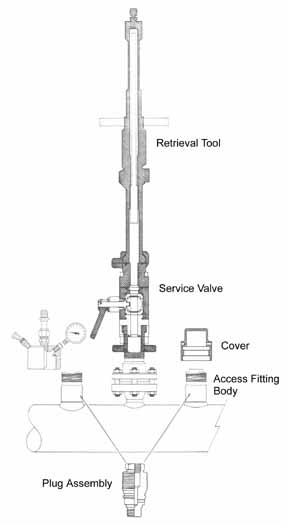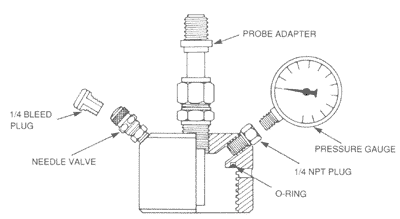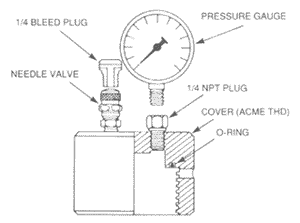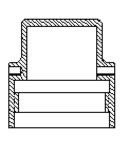Metex Corporation
Alabama Specialty
High Pressure Access Systems
|
When operated with a Retrieval Tool and Service Valve, high pressure access systems allow the installation and retrieval of: These devices can be installed or retrieved safely and without plant shutdown, at working pressures up to 3,600 psi. High pressure access systems are used most frequently (although not exclusively) in oil and gas production operations. This is typical of high pressure operations in which users are not prepared to shut down and depressurize process systems in order to remove or install corrosion monitoring devices. High pressure access systems consist of five basic components: The access fitting body is the specialized pipe fitting which is permanently attached to the process plant vessel or pipework. Access fitting bodies can be welded or flange-mounted. The plug assembly is the carrier for the installed device and, depending on the type of device being used, a solid plug assembly or a hollow plug assembly is selected. The plug assembly screws into the access fitting body and seals the bore of the fitting to contain line pressure. The access fitting body together with its plug assembly, and cover (designed to protect the external thread) is known as an access fitting assembly. The retrieval tool and service valve are the components which are required to perform the online installation and retrieval of the plug assembly. With the plug assembly removed during the retrieval procedure, the service valve is used to contain line pressure. One service valve and one retrieval tool may be used to maintain a number of access fitting assemblies. A variety of different devices have been designed for use with high pressure access systems. The following equipment can typically be installed into process lines using standard access fitting assemblies:
Using access fitting bodies which incorporate a side-tee, the following functions can be additionally undertaken:
Metal Samples Corrosion Monitoring Systems offers two different styles of high pressure access systems; the HP™ System and the MH™ System. The HP System is the generic design and is widely used throughout the world. This system is compatible and interchangeable with access fitting equipment produced by other major manufacturers. The MH System is a proprietary design of Metal Samples Corrosion Monitoring Systems and incorporates a number of unique and patented features which are an improvement to the generic HP System design:
Metal Samples Corrosion Monitoring Systems' Retrieval Tool and Service Valve are compatible with both the HP and MH Access Fitting Assemblies, but plug assemblies are not interchangeable between the two systems.
High Pressure Access System Access Fitting Bodies High Pressure Access Fitting Bodies are available in styles that may be welded (Flareweld, Socketweld, and Buttweld), threaded (NPT), or flanged (API, ANSI RF, ANSI RJ) to the pipe or vessel wall. Basic body styles are shown in the HP™ Access Fitting Bodies and the MH™ Access Fitting Bodies sections. Flareweld bodies are the most widely used. These bodies incorporate a reinforced welding neck and also have a radius machined into the base to accommodate the curvature of the pipe or vessel to which the body is welded. Access fittings are manufactured from materials which conform to NACE MR-0175 specifications for sour service. Choice of material for the access fitting body is based on minimum operating temperature as well as process stream corrosivity. "Standard" temperature materials are suitable for use above a minimum operating temperature of -20°F (-29°C). "Low Temperature" materials should be selected for minimum operating temperatures below this value. The Metal Samples Corrosion Monitoring Systems standard material specification for Flareweld Socketweld, Buttweld, and NPT bodies is AISI 1018 for standard temperature and ASTM A350LF2 for low temperature. For flanged fittings, ASTM A105 is used for standard temperature and ASTM A350LF2 for low temperature. However, all access fitting components can be made to order in any customer-specified material; carbon or stainless steel, duplex materials, or other more exotic alloys. All access fitting bodies have an external 3-inch ACME thread, which is used to attach the service valve during retrieval operations. Access fitting bodies should always be fitted with a cover which is designed to protect both external thread and also the service valve sealing surfaces. Tee Type Access Fitting Bodies Tee type access fitting bodies are available for use in applications where inlet or outlet access to the process stream is required. A side-tee port is drilled and tapped in the access fitting’s extra thick body to provide an integral connection point for a nipple and shut-off valve arrangement. Fittings with 1/4", 1/2", 3/4", or 1" FNPT side-tee ports are available as standard items. Tee type access fitting bodies are used with Chemical Injection Systems, Sampling, and Sand Monitoring Systems. If required, the side-tee port may be sealed off with a pipe plug. This would allow devices normally used with the non-tee type access fittings to be used with the tee type access fittings. NOTE: The installation and removal of the pipe plug requires the process stream to be shut down and depressurized. The materials of construction of tee type access fitting bodies is the same as the non-tee type access fitting bodies. Flanged tee type access fittings are also available upon request. Plug Assemblies The Plug Assembly is the retrievable carrier which holds corrosion monitoring, chemical injection, or various other devices which may be installed through the access fitting. There are two distinct types of plug assemblies - the Solid Plug and the Hollow Plug (see HP™ Plug Assemblies and MH™ Plug Assemblies sections). The plug assembly screws into the bore of the access fitting body and is designed to seal the fitting against line pressure. When tee type access fittings are being used, a pipe plug or nipple and shut-off valve is additionally required to seal the fitting. The standard material of construction for the plug assembly is 316 Stainless Steel. It should be noted that when stainless steel or duplex materials are specified for the access fitting body, the plug assembly should be specified to be Nitronic 60 to prevent thread galling. All plug assemblies are individually pressure tested at the factory and are rated for operation at 3600 psi. The operating temperature range for standard plug assemblies is -50°F (-45°C) to 350°F (176°C), but this range can be extended by use of alternative sealing materials. MH plug assemblies incorporate the following innovative design features which distinguish them from HP plug assemblies and plug assemblies available from other major manufacturers.
Solid Plugs Solid plugs carry coupon holders, injection/sampling systems, sand probes, and bioprobes A set screw arrangement is used with MH solid plugs to attach these devices for operation. With HP solid plugs, the solid plug nut is unscrewed from the base of the plug and replaced by the device being installed. A left-hand thread is used to ensure that installed devices do not become loose during the retrieval procedure. Hollow Plugs Hollow plugs are used with electrical resistance (E/R) probes, linear polarization resistance (LPR) probes, and hydrogen probes. To connect these devices with HP and MH hollow plugs, the hollow plug seal nut is removed and the monitoring device is screwed into the female thread in the base of the hollow plug. A left-hand thread is used. Access is allowed through the top of the hollow plug for electrical connections to be made directly to probes for the purpose of taking readings. Protective Covers Protective covers are designed with internal threads which mate with the access fitting body and are recommended to prevent damage to the fitting’s exterior thread. In addition, they protect the surfaces against which the service valve seals during retrieval operations. Heavy Duty Pressure Rated Covers Heavy duty pressure rated covers are manufactured as standard in AISI 1018 and are supplied with a paint coat finish suitable for the most aggressive environments. Covers are individually pressure tested for a pressure rating of 4000 psi and are available with an optional bleed valve and/or pressure gauge. Covers are available with or without a center hole. Center holes are required when an external sensor connection is required to be permanently installed. Covers with an unthreaded 1 3/8" (3.5 cm) diameter center hole are required for installations where mechanical Hydrogen Probes are installed. Covers with a 1/2" NPT center hole are required where continuous monitoring of electrical probes is required. Connection of an electrical probe to a permanent monitoring instrument requires the use of a probe adapter that extends through the 1/2" hole in the cover. The probe adaptor must be ordered separately.
Non-Pressure Rated Covers More economical than heavy duty pressure rated covers, non-pressure rated covers are internally threaded to protect against mechanical damage to the external access fitting threads. Non-pressure rated covers are available in plastic or metal, with the plastic version having the added advantage of being lightweight and non-sparking. They can be ordered with or without a center hole. |
||||||||||

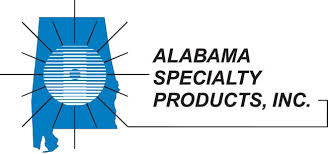
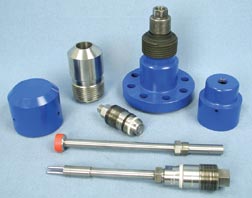 High Pressure Access Systems are specialized piping arrangements which permit internal access to production plant vessels and pipework operating under full process conditions. The corrosion monitoring industry standard for such access systems is based on a 2-inch nominal bore design.
High Pressure Access Systems are specialized piping arrangements which permit internal access to production plant vessels and pipework operating under full process conditions. The corrosion monitoring industry standard for such access systems is based on a 2-inch nominal bore design.